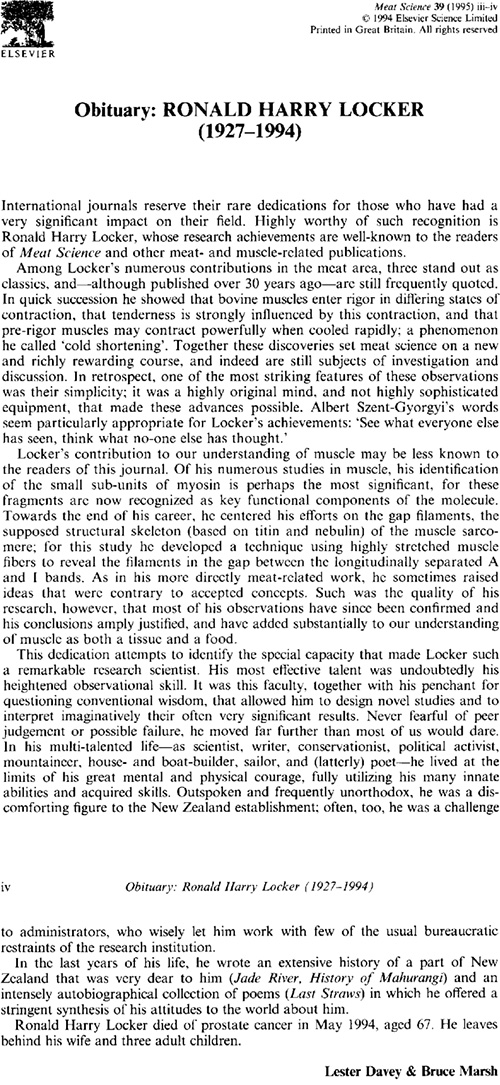Jade River: A History of the Mahurangi
Ronald H LockerFirst published 2001. Published online 2014–. This online edition is a work in progress…
Page viiin printed edition
About its singular meat-scientist author
Dr Lester Davey

A Discomforting Figure: ‘Outspoken and frequently unorthodox, he was a discomforting figure to the New Zealand establishment; often, too, he was a challenge to administrators, who wisely let him work with few of the usual bureaucratic restraints of the research institution.’ Lester Davey and Bruce Marsh Elsevier Science
Ronald Harry Locker’s links with the Mahurangi go back to his Jamieson great-grandparents, early European settlers in the district. Derived from the association was a lifelong and passionate interest in how both natural and human forces have shaped the region.
He was born in Papatoetoe in 1927 and he died in Hamilton in 1994 aged 67. From Auckland Grammar School he went on to graduate with a doctoral degree from Auckland University specialising in chemistry of plant flavonols. He moved to Otago University in 1952 to train in biochemistry and thence to Cambridge University for two years where he developed specialist skills in the field of protein chemistry. Throughout his working life, until he retired in 1986, he was a senior scientist at the Meat Research Institute in Hamilton, where he undertook studies into the structure and function of muscle tissue and into the science of meat. In both fields he achieved high international recognition and, of any decade, can be classed as one of New Zealand’s outstanding scientists.
Ron Locker was a courageous and unyielding advocate for causes of high principal. He never believed the science and politics should not mix. He was involved in all protests against nuclear weapons from the beginnings of the Campaign for Nuclear Disarmament in New Zealand; in the first petitions for a nuclear free Southern Hemisphere; and in campaigns against an Omega base here and our involvement in the Vietnam War. He had a long and notable involvement in conservation, national parks policy and indigenous forests.
He was the author of more than 60 scientific papers and review chapters in books relating to muscle and meat science. He was an inveterate contributor to seminars, periodicals and newspapers both on agricultural issues and questions of social concern. He was co-author with John Morton and David Thom of the book Seacoasts in the Seventies (Hodder and Stoughton, 1973). The book has stimulated national concerns relating to the need for comprehensive coastal development strategies.
In his latter years, until a few weeks before his death, he turned his talent as a wordsmith to writing poetry. He compiled an intensely autobiographical collection of his poems (as yet unpublished) titled Last Straws. His History of the Jamieson Family (also unpublished at his death) appears in part in this book.
Ron Locker’s most effective talent was his highly developed and penetrating observational skill. It was the essence of his science whether in the laboratory, on the geological landscape of the Mahurangi, on the river in the boats he built, or as a botanist when exploring the surrounding indigenous forests of the region.
It is this special observational skill that he brought to bear in creating this history. He completed it with urgency, not only because of potent of his own death, but also from the realisation that the spill-over from Auckland had begun to obliterate the trails. He felt that a definitive history of how stable footholds were achieved along the Mahurangi River and in the surrounding region was a timely endeavour.
Publisher’s note One of the many beauties of online publishing, in addition to it being considerably less costly, particularly to the climate, is that further subediting is possible, including the opportunity to use macrons on those Māori vowels requiring them. An enormous online utility, of course, is the ability to link.
